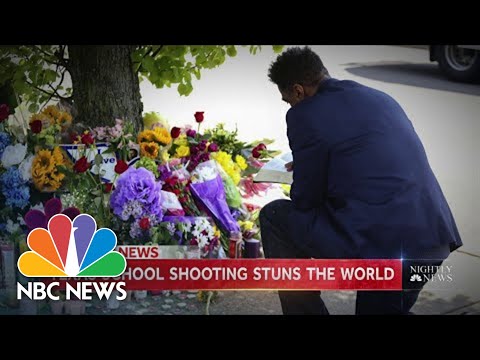The year 2023 is on track to be the worst in recent history for mass shootings in the US, according to the Gun Violence Archive database. Some commentators are questioning whether security fears surrounding gun violence and mass shootings could keep international fans away from the 2026 FIFA World Cup in Los Angeles.
No other developed nation has mass shootings at the same scale or frequency as the US. Estimates suggest that Americans own 393 million of the 857 million civilian guns available, around 46% of the world’s civilian gun ownership.
A 2013 report by the European Commission found just 5% of EU citizens owned a gun, compared to around 32% of Americans in 2020. And the US figure is expected to have increased in response to recent shootings.
Whenever another mass shooting takes place, foreign politicians and media react with incomprehension that American gun laws differ so much from those of most other Western nations. Thirteen US states allow open carrying of a gun without a permit, and 25 (soon to be 26) don’t require a permit to wear a concealed gun in public.
Several nations have now issued their citizens with US travel warnings relating to gun violence.
Uruguay has suggested its citizens avoid certain cities, including Detroit and Baltimore. Germany warns of the possibility of killing sprees and that arms and ammunition purchases have increased significantly since the Covid-19 crisis.
Canada now recommends its citizens familiarize themselves with how to respond to an active shooter before visiting and warns of mass shootings. Australia’s official travel advice warns “gun crime is prevalent.”
Even Venezuela, ranked one of the world’s most dangerous countries, issued its highest advisory against travel to the US following mass shootings, starting from 2019.
China has also warned its citizens that they were traveling to a country with “frequent shootings.” The New York Times reported that the Chinese foreign ministry issued an advisory urging citizens to “be careful and prepare for the possibility that gun crimes may occur at workplaces, schools, at home and at tourist sites.”
In 2022, research by data analysis group Morning Consult found that a staggering 93% of Chinese nationals who wanted to visit the US were so worried about violent crime that they may not make a trip.
Tourism and violence
Journalist Rosie Spinks has questioned how America has managed to remain a “safe” country to visit, while similar incidents happening elsewhere would instantly cause countries to be locked off to international visitors.
In June 2015, a mass shooting took place in the Tunisian resort of Port El Kantaoui, killing 39 people, mostly tourists. The massacre dramatically affected Tunisia’s tourism industry and thousands lost their jobs.
For three years the UK advised against all travel to the country, with much of the world implementing similar policies. Research found that even in other Muslim countries that had no connection to the attack, their tourism industries were negatively impacted.
That is not to say that governments were wrong for canceling holidays to Tunisia. Tourists’ safety should always be top priority.
Yet in the year of the Tunisia shooting, there were 372 mass shootings in the US. Meanwhile, the country welcomed a record number of overseas visitors. The difference here may be that Tunisian shootings were aimed at tourists.
Perhaps a destination’s ability to rebound after tragedy is often down not to the realities on the ground, but to our perceptions of safety. And these perceptions often come from prejudices, media bias, and governmental advice that favors certain destinations.
How do nations protect tourists?
Safety and security are vital for the tourism industry. More than any other economic activity, the success or failure of a tourism destination depends on being able to provide a safe and secure environment for visitors.
Some places opt to cocoon their tourists in enclave resorts, where they are protected in specific zones. The Egyptian resort town of Sharm El-Sheikh, for example, has been encircled by a 22-mile-long, six-meter-high wall, to protect its tourists after several violent incidents shook the Egyptian tourism industry.
Those wishing to enter the resort by road must now pass through gates equipped with cameras and scanners, while planes land directly within its walled interior.
Although these measures may seem unrealistic for the US, some areas that rely heavily on tourism have already put controls in place to protect their visitors. Loaded guns were once banned in all US national parks and wildlife reserves, until Barack Obama controversially overturned the 20-year law during his first month in office.
Walt Disney World has a strict no-gun rule in its theme park, yet reported seeing a sharp increase in people trying to enter with concealed weapons in 2021.
Gun violence in the US doesn’t seem to be going away, but global awareness and scrutiny of US gun laws and violence seems to be increasing.
Tourism is a big business in the US: in 2019 international visitors injected a staggering US$233.5 billion into the American economy. If the US hopes to maintain a positive tourism image and continue to attract visitors, it may soon have to consider how gun safety looks to the outside world.
Ross Bennett-Cook is Visiting Lecturer, School of Architecture + Cities, University of Westminster
This article is republished from The Conversation under a Creative Commons license. Read the original article.


